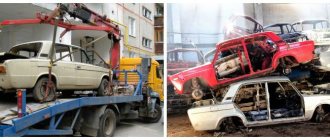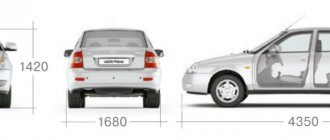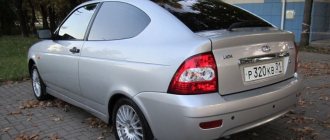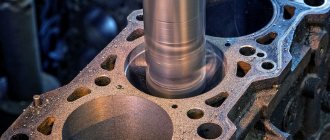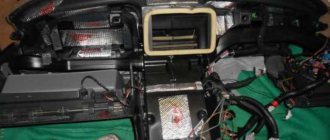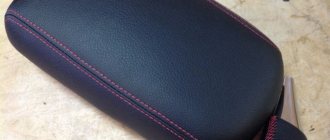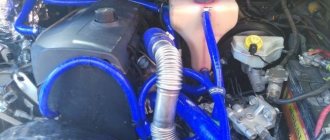Published: 10/30/2020
- Is the body of the Lada X Ray galvanized? Interesting facts about the car, personal experience, price, pros and cons.
- Do they process only Vesta?
- Reliable body with high corrosion resistance
- Lada Vesta body
- Galvanized sheets are not used during assembly
- What is galvanized and what is not
- Where it rusts
- Examination
- Painting Lada Vesta
- Does Lada Vesta need additional anti-corrosion treatment?
- Why use a primer for galvanizing?
- Painting Lada Vesta
- Salt fog
- Coating thickness
- How does galvanizing happen?
- Primer for hidden body cavities
- Four types of technologies
- How does the box synchronizer work?
Is the body of the Lada X Ray galvanized? Interesting facts about the car, personal experience, price, pros and cons.
Is the body of the Lada X Ray galvanized?
The car cannot be worn out with expensive finishing materials, and they cannot be called overtly inexpensive. But there are no complaints about the fit of the dashboard parts, other parts and interior door upholstery: it is possible, of course, to obviously forget about creaks and other unpleasant things in the interior of this VAZ model. The interior of LADA XRAY is:
- Beautiful design. Just look at the dashboard, taken from its fellow B0 platform and with its inimitable fonts.
comfort and thoughtfulness. This is facilitated by such pleasant little things as, for example, a storage compartment under the front passenger seat or a double bottom in the trunk. Not bad sound insulation, an order of magnitude higher than that of cars previously produced by the automaker.
New Lada X-Ray from the representative of AutoHERMES
Do you want to buy a LADA XRAY in Moscow at a dealer price? Contact a Russian car dealership. AutoHERMES offers successful conditions for the purchase of this Lada X-Ray hatchback in 2016-2017, both on loan and leasing. We are also ready to accept your old car against the price of a new one.
Contact us.
The article talks about whether the body of the Lada X Ray is galvanized, compiled from the opinions and experience of car owners.
prices and options
Informational and entertaining video about whether the body of the Lada X Ray is galvanized, the best moments and comments from the presenters.
You can read the latest news about whether the body of the Lada X Ray is galvanized on our website in the near future.
Р'озможно, неправильные RїР°СЂР°РјРµС‚СЂС‹ соединения пли РЎРЈ Р Р'Р” РЅРµ запущена
lada-vesta.jacrein-club.ru
Do they process only Vesta?
Many will now ask why the manufacturer began to think about this issue only with the release of Vesta. This is not entirely true. The fact is that other VAZ models were also galvanized. These are Priora (models after 2009), second generation Kalina and Lada Granta. But as before, the body was not completely processed. Thus, on the Kalina there was no galvanization on the rear and front side members, the roof and the hood. To eliminate corrosion at least partially, it was necessary to install wheel arch liners. The Priora was treated almost everywhere, with the exception of the roof and hood. But again, you can’t do without lockers here.
"Vesta" is treated with zinc over the entire outer surface (including the rear fenders), except for the roof. Additionally, some areas are treated with anti-gravel. These are the sills, the bottom and the arches. Yes, AvtoVAZ has previously used cold galvanizing technology. But it is best implemented on Vesta.
The suspension has at least 4 minuses
During the first months of operation, the Lada Vesta caused the greatest criticism regarding its suspension. Many car enthusiasts complain about various knocks and squeaks. Motor design problem:
- front anti-roll bars, which produce a characteristic creaking sound when the Lada Vesta travels long distances;
- stabilizer struts are knocking;
- sounds appear in the front suspension when turning the steering wheel;
- The shock absorbers in the rear suspension are knocking due to the poor design of the supports, which are being replaced with more elastic and self-absorbing ones.
On average, after 4-6 thousand kilometers, Lada Vesta owners notice and complain about the creaking of the stabilizer rubber bands when going over bumps on the road.
After a run of 40-50 thousand kilometers, play may appear in the lower bearings of the steering knuckle. Low mileage rates according to the average statistical data of the operation of similar units.
Reliable body with high corrosion resistance
Cars from the Russian automobile industry have always had one common drawback that reduces their service life - the body is sensitive to damage and corrosion.
Specialists from AvtoVAZ decided to get rid of this disadvantage once and for all and developed a fundamentally new body, equipping it with an additional layer of protection. On many portals there is the same question that is asked by those who want to buy this car: “Is the body of the LADA Vesta galvanized?”
The answer will greatly please potential buyers. AvtoVAZ says: “Yes.” According to the manufacturer, thanks to the galvanized body, the new models will be extremely resistant to corrosion. For about 5-7 years, the car owner will not see a single trace of damage, which will significantly reduce repair costs. The manufacturer itself provides a 6-year warranty against corrosion. After this, it is recommended to carry out additional treatment of the LADA Vesta body in order to increase the service life of the car.
The method of applying the galvanized layer, alas, is the simplest - the so-called “cold method”. This is the cheapest way to increase the survivability of a car body. On LADA Vesta, absolutely the entire outer surface of the body is galvanized. At the same time, the arches, sills and bottom are treated not with zinc, but with anti-gravel, which allows the process of rotting and rust to be delayed for a long time.
Despite the fact that a significant part of the body surface is protected by zinc, free cavities still remain vulnerable. All the metal in the cavities, ventilated and covered with casing, will not be able to last long unharmed. Therefore, the manufacturer decided to additionally protect the metal by applying primer to the internal cavities.
Galvanizing alone will not be enough
After assembly, cavities remain in the body of any car. The Lada Vesta is galvanized on the outside, and there is nothing protecting the metal in cavities that will be covered by the skin or even left ventilated. With this approach, the metal will not last long. Therefore, the body is treated with primer to protect all internal surfaces.
Vesta body after priming
The technology used is very simple - cataphoresis, or cataphoretic precipitation. Here you need a bath, and AvtoVAZ has one. Just like on IzhAvto.
Cataphoresis bath in action
In theory, four layers are formed on the outer surface of the sheet: zinc, primer, paint and varnish. We will call the last three the word “LCP”. The thickness of the paintwork on the Vesta body is as follows:
- Roof – 103-128 microns;
- Doors – 140 microns;
- Wheel arch fenders – 140-144 microns;
- Hood – 104 microns;
- Trunk lid – 125 microns.
This is the result we will get using an ultrasonic thickness gauge.
How the measurements were carried out
Primer on top of zinc - why is it used?
Lada Vesta is galvanized to the maximum, but if there is no primer or its layer is too thin, the zinc is consumed, that is, the coating becomes thinner. A layer of paint and varnish has never been an obstacle to air or moisture.
Based on the number “9”, VAZ should have given a guarantee for 8 years. But in reality, the thickness of the zinc layer varies, and in few places it exceeds 8 microns. Therefore, the warranty period for the body is 6 years. By the way, before the launch of the release, a different value was discussed (5 years).
Lada Vesta body
LADA Vesta is a compact car produced by the Russian company AvtoVAZ, which is designed to replace the slightly outdated LADA Priora. The sale of Vesta began in 2022 and continues to this day. Last year, the company released a whole line of new LADA Vesta models, including LADA Vesta Cross in a new body, Vesta CNG and others.
The main distinguishing features of this car are an increased level of safety - in this indicator, domestic models even surpassed the Ford Focus, and a stylish European design.
The body of the LADA Vesta was developed according to completely new standards for the domestic automobile industry. The car is more similar to its competitors from the European and American markets than to those models that were previously produced in Russia by AvtoVAZ.
Modern sedan from AvtoVAZ
Lada Vesta SV cross volume. technical characteristics of Lada Vesta sw cross. ground clearance of Lada Vesta SV Cross
In November 2015, sales of the first car in the Lada Vesta line, a sedan, began. Its design solutions are based on the V/S platform, developed by AvtoVAZ in 2010. It was used at the Lada Silhouette concert. The technical part was finalized by Renault-Nissan specialists, which led to the introduction of a foreign steering wheel with an electronic amplifier, a radiator, electrical equipment, and a rear suspension beam into the car. In terms of size, this model is compared to the Polo sedan from Volkswagen. The new car is equipped with a VAZ-21129 engine with 106 hp. and a volume of 1.6 liters with a Renault manual transmission or a gearbox of its own production. And from mid-2016, the sedan will be produced with the Nissan HR 16 engine, which has 114 hp and a volume of 1.6 liters, currently installed on the Nissan Sentra.
The sedan has several versions: Classic, Comfort, Luxe. The simplest Classic received an estimate of 514 thousand rubles. It is equipped with an airbag for the driver's seat, stabilizers, an on-board computer, front electric windows and power steering. The Comfort version costs from 570 thousand rubles and, in addition to the previous configuration, includes airbags and heated front seats, air conditioning, an audio system, electric mirrors and rear parking sensors. The Luxe sedan version is priced at 609 thousand rubles, which additionally includes rear electric windows, rain and light sensors, a heated windshield, alloy wheels and foglights, and for an additional fee a multimedia system with a touch screen, a navigator, and a camera providing rear view is provided. , and a cruise control device.
Galvanized sheets are not used during assembly
Even a non-specialist can see whether the body of the Lada Vesta shown in the photo is galvanized.
The sheets were cut, bent, welded
Here we see ordinary steel, not coated with anything. Galvanized steel is not used, for which there are reasons:
- Welding only joins uncoated materials;
- It is not clear on which machines to cut and further process galvanized sheets;
- A sheet of steel, galvanized even on one side, will cost 3 times more than regular sheet metal.
A zinc layer that is too thick (20-30 microns) will crack quickly. But VAZ is doing just fine with this parameter.
There are a lot of articles about cold galvanizing at VAZ, and I believed that it is not a layer of zinc that is applied, but a zinc-primer mixture, after which the primer is not applied. But the author writes that a layer of zinc is applied, then a primer in the bath. Why prime again? Why can’t the inside be coated right away or is it expensive?
At first I was also perplexed: they galvanize, but only halfway. For what? And then I remembered: in our country everything comes at some point, good beginnings end in death...
If you coat metal sheets with zinc on both sides, then it cannot be further processed by pressure or bending (it breaks). In the West, galvanization is not used at all.
Yeah, what are the Germans doing then? Almost all of their models are galvanized.
A six-year warranty is a very good period in any case. These cars certainly won’t rust and rot like Nivas.
yeah but it's from through corrosion
There’s no need to spread rot on NIVA, I have a 5-year-old Niva, manufactured in 2011, and it doesn’t think about rotting.
The manufacturer has already galvanized its models. Galvanizing Vesta should improve strength. Well, yes, in any case, a long guarantee.
The main thing is that it exists. Of course, I would like it to be of better quality, but in comparison with the price, this is a very real way out of the situation aimed at reducing the cost of the final product.
a ton of metal is 10,000 rubles three times more expensive = 30,000 rubles, and the car drives quietly and does not stand under a fence!
Renault Logan is galvanized using the electroplating method in an electrolyte bath. Is the Lada Vesta primed with zinc metal? After all, this is not full-fledged galvanization, which is our brains! The warranty on the body is 6 years, and the Koreans have 8 years (with galvanization). zinc metal is not full-fledged galvanization
I asked the question whether the Lada X-ray is galvanized: Some car enthusiasts may be extremely interested in how the car body is galvanized. The process can be described quite simply. The part to be processed (already in finished form, stamped on the assembly line) is immersed in a heat-resistant bath filled with molten zinc. The melting point of zinc is over 400 degrees Celsius, so the entire process is carried out automatically, which ensures high accuracy and quality of processing. Due to the high temperature, a thin layer of galvanizing is partially mixed with the molecules of the metal from which the part is made, thereby ensuring strong adhesion between the part and the shell, which protects it from corrosion. This procedure allows you to completely deprive the workpiece of areas that are not protected from rust. Material from the site: ixraylada.ru Who to believe?
An acquaintance bought a Vesta, drove it down a dirt road to the village, and all 4 doors jammed, he took it to a service center and quickly straightened the body and sold it to the Vesta and draw your own conclusions about what kind of car it is.
Either you or your friend have a rich imagination
I doubt that this is true. I drove the rusty 21083 along the village road, and nothing stuck. Maybe you're talking about the Daewoo Nexia?
This figure filled the entire Internet with this opus, apparently they paid well. Relying on consumer ignorance. There is not a word of truth in the article, it is some kind of ignorant nonsense in reality. All manufacturers weld the body from metal, galvanized on both sides. The strip is galvanized in a metallurgical plant either by immersion in a hot melt or galvanically in a solution. All front parts, partly the bottom and part of the brackets are made of this steel. Most manufacturers make the roof non-galvanized, because it makes no sense and is expensive. This is the same on Vesta, which is why there is a 6-year warranty, which previous models could not have had. Plus, Vesta has three times more protection for seams with mastic and a new technology for protecting cavities with wax. More than two years have passed, but try to find reviews that Vesta is rotting - no. I wonder if this review will pass? I wouldn’t be surprised if all these sites are from the same “manufacturer”.
Georgy, take two galvanized parts and weld them. Then write how it turned out
If you do as you say, then the welding areas are then galvanized again? So why the hell then boil galvanized metal, when you can then galvanize everything at once.
About myths
Almost everything has been clarified, but again, many skeptics who are accustomed to saying that there is nothing good at AVTOVAZ can put forward some theses:
- Foreign cars are made from fully galvanized sheets . Perhaps someone does this (in their barn in particular), but in most industries around the world such sheets are not used. They are soft (do not have the required strength), do not weld well (easily burn through), the cost of the body will go through the roof
- The cold method is used only at AVTOVAZ . This is also not true, for example Chevrolet, KIA, HYUNDAI, TOYOTA, MITSUBISHI use it on many of their cars (even if they are of a budget class, but still). For example, CRUZE is covered worse than VESTA, it does not have sill treatment and some front power struts
- The layer is so thick that it falls off . I really don’t understand who comes up with this idea. If you check with a micrometer, it turns out: the roof is about 105-125 microns, the doors are about 145 microns, the wings are 140 microns, the hood is 110 microns, the trunk lid is 120 microns. This is a complete “pie” that is applied to the steel. It is approximately the same as on many foreign cars of this class and nothing falls off on anyone.
- Only VESTA is processed; other VAZs are not treated ! This is again a myth. Galvanization is applied to the following models: GRANTA (LIFTBACK) - fifth door, fenders (here is the bare minimum of galvanizing), KALINA2 - all external surfaces, except the hood, roof, front and rear side members (fender liners are needed here), PRIORA (since 2009) - everything except the roof, hood. X-RAY - everything outside, except the roof, VESTA - the entire external surface, with the bottom, sills and arches additionally treated with anti-gravel.
What is galvanized and what is not
You can list VAZ models in increasing order of galvanized area:
- Granta sedan – minimum galvanized parts;
- Granta liftback - the same as in the sedan, plus a fifth door and wings;
- Kalina 2 - all parts except the hood, roof, front and rear side members;
- X-Ray - the entire external surface, but the roof is not galvanized;
- Vesta is the entire outer surface. The bottom, sills and arches are additionally treated with anti-gravel;
- Priora - double-sided galvanization (after 2009).
The reader probably already understands whether the body of the Lada Vesta is galvanized. Different galvanizing schemes are used for different models. The GM concern, for example, adheres to the same ideology as VAZ.
This is how the Chevrolet Lacetti sedan is galvanized
Zinc is applied from the outside, covering a significant part of the surface. For Priora, the scheme looks more solid.
Part 3 – floor screen
Cold galvanizing
Unlike the hot method, here the body does not fit into the bathtub. Zinc is applied from a spray bottle.
- "Chevrolet".
- "Kia" (below the C-class).
- VAZ (including Lada-Vesta).
After this treatment, the body metal is protected from corrosion. But this method has its drawbacks. Thus, with cold galvanizing it is impossible to achieve such a uniform and seamless coating as with hot galvanizing.
Where it rusts
There are problem areas on the body of my car. For example, on the front fender and in other places there are abrasions and chips down to the metal, but there is no rust yet. Under the hood I looked at the bolted connections, the joints, so far everything is in order, not rusting.
I found a rusty part under the hood on the right side as the car was moving.
I also found a place with metal corrosion. This is the bottom of the front left door from the inside.
Such body defects can only be found on internal surfaces. This is due to galvanizing technology. They will have to be treated with something, otherwise in 2-3 years there will be through holes. This is how we treat Lada Vesta at the factory. My car is only 3 years old. Surely the body was galvanized poorly and the primer was poorly applied.
Share information about the situation with corrosion on your cars.
ON THE COFFEE GROUNDS
Alas, the manufacturer did not give any comments to the request from the editors of Za Rulem about the details of the rust problem. Therefore, we can only make assumptions, comparing the information received from some dealers and on owner forums, as well as the experience of operating the Crete in our fleet.
Judging by the fact that the service bulletin applies to machines manufactured before December 15, 2022, there is hope that the causes of the defect have been found and changes have been made to the technological chain on the assembly line. At least so far there is no information about such problems on 2022 vehicles. The manufacturer did not want to reveal the secret, and dealership employees only have assumptions about the causes of such a strange problem.
The actual scale is also unclear. Questionnaires on two large forums showed that about 25% of owners encountered rust. However, only 850 people took part in these votes. The collective electronic petition has not collected much either - to date, only 427 signatures. To put this into perspective, almost 22,000 Cretes were sold in 2022. Some dealers also talk about the low percentage of “sick” cars identified during the service bulletin period. That is, on paper, owners of cars manufactured before December 15, 2022 do not have much of a chance of seeing rust on the trunk lid, but still no one is immune from this.
During the debate about the nature of rust, a curious fact emerged - the uneven and in some places too small thickness of the paint layer. There are videos on the Internet where instruments show only 80 microns on the edges of body panels, as if there is no varnish. At the same time, the participants in the video confirm on calibrated probes that the thickness gauge is calibrated correctly.
The thickness of the paintwork was tested on several machines. It was not possible to see examples with indecently low 80 microns, but thin and too heterogeneous places were found. The experiment involved two Cretas from our fleet (2016 model year) and several new cars (2017), which were still waiting for buyers. In general, all participants with different body colors showed similar results.
Examination
A crossover was selected for inspection for test drives, 1 year old and with a mileage of 6400 km. He was driven onto an overpass, after which a check began. First, it was necessary to determine how well the car was processed from the factory in order to understand what actions to take.
Bottom
When examining the bottom, you can see that from the factory it has been perfectly treated with anti-gravel on the outside, and the welds have also been sealed. Judging by the applied composition, it is noticeable that this was done at the factory, and not at the dealership. In particular, you can find small areas where there is only a primer and no anti-gravel composition. But they are very small, and therefore do not pose a great danger. As a result, after a year of operation there are no noticeable areas covered with rust on the bottom.
Next, one of the plugs was removed from the spar to check how well the plant preserves the elements from the inside. After all, it is inside that corrosion begins to spread first - the formation of condensation, etc. Because of this, welds suffer.
However, in the case of anti-corrosion treatment of the Lada X-Ray, no such troubles were identified. After checking, it turned out that all the cavities were properly filled with a wax-based preservative.
Next, the threshold drainage holes were inspected. They turned out to be not only qualitatively processed (there are traces of excessive leakage of the composition, therefore, the internal cavity of the threshold is covered with anticorrosive), but also completely free, which means that condensate removal is as efficient as possible.
Small pockets of corrosion were recorded on the threads of the bottom studs, since they were not protected by anything. At first, this point will not have any effect, but over time, this problem will progress and later unscrewing the nuts will become problematic, and therefore it is recommended to check the threaded connections and treat them with lubricant.
Rust on threads
All tubes are protected by a special plastic casing, which is made in the form of a grid on the road surface side, which guarantees high-quality removal of moisture, dust and dirt. Naturally, off-road this element will not protect the hoses from a strong impact, however, from the point of view of anti-corrosion treatment of the Lada X-Ray, this decision is certainly correct.
The central tunnel is completely covered with panels made of heat-resistant and sound-absorbing material.
As in the case of the central part of the bottom, the rear spar is reliably protected from the inside - after removing the plug, there is abundant leakage of the wax-based compound.
All checks inside the side members were carried out both visually and using a special probe
It is also important that the preservative does not just lie in spots or concentrate directly at the technological hole, but is evenly distributed over the entire internal plane of the spar
The only weak point is the central part of the spar, where there is noticeably less inside the composition, and therefore it is recommended to independently carry out anti-corrosion treatment on the Lada X-Ray in this direction and eliminate minor defects.
Doors
At the bottom of the front doors there are sufficiently large drainage holes that provide effective moisture removal. Preservative stains are also visible in them. The downside is that there are only 2 holes - at the edges. There is no central hole.
As a rule, AvtoVAZ does not treat the side end of the door from the inside with anticorrosive, and therefore it is recommended to treat this area yourself.
The side end of the front door, which is often not processed
The tailgate features only one drain hole, but it is located at a low point for improved efficiency. There is also a preservative.
The fifth door has several drainage holes, and after checking with an endoscope, it is noticeable that the inside surface of the metal is coated with anti-corrosion.
As you can see, there are no questions about the doors for anti-corrosion treatment of the Lada X-Rey.
Wheel arches
The rear arches are completely covered with lockers with noise-absorbing characteristics (there is a fleecy outer layer).
Painting Lada Vesta
Painting of the car begins after the application of primer has been completed. Step by step, the car is prepared for the painting procedure. Since painting is done with an aerosol in several layers, robot labor is used. A solution is applied to the surface, strengthening the seams and protecting the body from corrosion. Then noise-insulating mastic is used, which adds silence to the car on the roads.
When applying primer coating with robots, many hard-to-reach places remain and have to be processed manually. The inner sides of the pillars, the edges of the roof covered with doors, are finished manually. The primer comes in two tones: light or dark. Choose depending on the color of the car.
Once the priming stages are completed, the car is sent to the next conveyor for developing the secondary layer. Here, specialists eliminate paint coating application defects and coat the seams with brushes and paste. After all the procedures, specialists, with the help of robots, proceed directly to painting the car. The paint application process is not complicated. A common aerosol spray that motorists have dealt with. A layer of varnish is applied over the paint, and the finished painted and varnished body is sent to dry, which takes an hour. The entire painting procedure lasts no more than four hours.
When the body is dried and the varnish is applied, there are a few final steps left, after which we get the product in the form in which it ends up on the market. The final touches are polishing and applying anti-corrosion. The result is a durable, galvanized body of the Lada Vesta. Let us remind you that the thickness of the car’s paintwork is higher than that of other parts of the car, which makes it reliable and resistant to changing weather conditions.
What will affect body rigidity?
Torsional rigidity in all cars is established at the moment the metal thickness is determined. There is a certain range of numbers that fits two limits at the same time. The first is the maximum permissible weight of the car (body parts that are too heavy are not at all the optimal solution). The second is the minimum permissible metal thickness for decent strength of the machine frame.
In the future, torsional rigidity is increased with the help of an internal body kit - factory and custom (installed by the car owner of parts from other manufacturers) spacers, which create pressure on the opposite ends of the body, thereby reducing the amplitude of their vibrations and the vibration itself.
Does Lada Vesta need additional anti-corrosion treatment?
Above, we have already examined the strengths of paintwork and the presence of galvanization. To answer more precisely, you need to understand what the car body is made of. Low carbon sheet steel is a component that makes up the body. Steel is prone to corrosion. If we add that the body is not completely galvanized, but is protected only from the outside, the conclusion suggests itself - factory galvanization is not enough.
During one of the test drives conducted by Russian auto experts in the first months after the release of Vesta, it was noticed that the inside of the car and especially the bottom were galvanized somehow. The car is well made, but if you look deeper, you can feel the manufacturer’s signature. There are several types of application of additional primer, which are used depending on the primary galvanizing method.
Why use a primer for galvanizing?
If everything is clear on the inside, there is no protective layer and primer is required - but why apply it to the outside, where there is galvanization?
If you remember, I wrote above that the larger the layer of this non-ferrous metal, the longer the body steel lasts. SO - the layer that is sprayed is not so large and it needs to be further strengthened.
That is, ideally it should be enough for 8.7 years, that is, almost 9 years. However, AVTOVAZ does not provide a guarantee for such a period, due to several factors:
- Application is carried out by spraying, and there is no guarantee against defects (especially if painted by hand).
- As practice has shown, the layer is often about 8 microns
Thus, they extended a 6-year warranty on the body; by the way, when this model was launched, they wanted to give it 4–5 years. Now technology has improved a little.
Hot-dip galvanized vehicles
It should be noted that brands of cars with this type of protection are much more expensive. But the technical side of this issue is fully consistent with the price.
List of vehicles with this coating method:
- Porsche (the first brand was the Porsche 911);
Porsche 911 hot-dip galvanized car
- Volvo - produced since 1975;
- Ford - produced only selectively (“Escort”, “Sierra”, “Fore-Mondeo” assembled in Belgium);
- some models from ;
- Chevrolet (Epica and Lacetti);
Chevrolet Lacetti car with hot-dip galvanizing
- "Fiat Albea" and "Fiat Marea";
- Opel Astra, Opel Vectra.
Opel Astra car with hot-dip galvanizing
It is noteworthy that the first car with such a coating was released. It was they who invented the method of applying zinc to the car body and patented it. Since 1986, all Audi models have come out with such a protective surface.
Painting Lada Vesta
Painting of the car begins after the application of primer has been completed. Step by step, the car is prepared for the painting procedure. Since painting is done with an aerosol in several layers, robot labor is used. A solution is applied to the surface, strengthening the seams and protecting the body from corrosion. Then noise-insulating mastic is used, which adds silence to the car on the roads.
When applying primer coating with robots, many hard-to-reach places remain and have to be processed manually. The inner sides of the pillars, the edges of the roof covered with doors, are finished manually. The primer comes in two tones: light or dark. Choose depending on the color of the car.
Once the priming stages are completed, the car is sent to the next conveyor for developing the secondary layer. Here, specialists eliminate paint coating application defects and coat the seams with brushes and paste. After all the procedures, specialists, with the help of robots, proceed directly to painting the car. The paint application process is not complicated. A common aerosol spray that motorists have dealt with. A layer of varnish is applied over the paint, and the finished painted and varnished body is sent to dry, which takes an hour. The entire painting procedure lasts no more than four hours.
When the body is dried and the varnish is applied, there are a few final steps left, after which we get the product in the form in which it ends up on the market. The final touches are polishing and applying anti-corrosion. The result is a durable, galvanized body of the Lada Vesta. Let us remind you that the thickness of the car’s paintwork is higher than that of other parts of the car, which makes it reliable and resistant to changing weather conditions.
Quality of priming and painting
Thus, Lada Vesta sedans are rolling off the assembly line, fully complying with the standards of the Renault-Nissan Alliance. This is confirmed by inspections that were repeatedly carried out not only by interested amateurs, but also by experts. As it turned out, no cases of underpainting of metal panels, traditional for AvtoVAZ, were noticed. There are no paintwork defects, such as abrasions, scratches and the like, which were often noticed on Priora, Kalina and other models.
Chips are not uncommon for any car, including Lada Vesta. But because of this there will definitely be no “saffron milk”.
But the thickness of the paintwork is not too great. However, this is a modern trend for all cars - constantly tightening environmental standards do not allow applying a deep layer of paint and varnish. On the other hand, even chips do not lead to the formation of rust on the metal panels of Vesta - high-quality soil softens the impacts of pebbles and other road debris without exposing the iron.
Salt fog
Strength tests of the primer are carried out in a salt fog chamber. It is worth noting that in the 70s the coating did not last even 100 hours (about 96 hours), which is extremely insufficient today.
At the moment, the development of technology and the increase in the quality of 2-component primer have made it possible to increase the period to 1500 hours.
The salt fog itself is a continuous spraying of a 5 percent concentration of table salt solution in a special chamber. During 1 cycle for 7 days without breaks, this solution is poured onto the body, after which it dries, then poured again and dries again, etc. In total, the body of the Lada Vesta and X-Ray went through 5 such cycles - this is equivalent to operating the car in an industrial environment. city for 4 years.
During the inspection process, calibrated cuts are made on the metal - these are very deep scratches right down to the metal itself. However, galvanizing the body of the Lada Vesta and X-Ray protects against corrosion even in such situations.
However, calibrated cuts alone do not provide a complete picture, so body panels (hood, rear fenders, etc.) are cut to look inside and assess the condition of the internal cavities.
The first cut was made at the leading edge of the hood. Inside, gray soil and a layer of anti-corrosion are noticeable.
The second cut is on the rear wing - in this case, a layer of gray soil and an anti-corrosion compound are also visible, which, however, is concentrated in the area of the seams and bends, while there is little of it on the plane. By the way, Vesta and X Ray use a new generation of anticorrosive, which flows much better in seams, bends, flanges and joints.
AvtoVAZ promises
Representatives of the plant more than once, during the preparation of the new sedan for production, said that it would be assembled at a fundamentally new level. This also concerned the eternal problems of domestic cars - weak paintwork and the rapid occurrence of corrosion. Everyone remembers how the same Priors began to bloom with saffron milk caps within six months to a year after purchase! For modern cars this is bad manners. It is not surprising that Lada owners, as well as those who were just trying to buy one, demanded the release of cars with galvanized bodies.
Lada Vesta bodies are being prepared for painting at a completely different level.
Knowing how many complaints were pouring in about their products, the leaders of the Russian concern hastened to assure the public that this would not happen to Vesta. In addition, it was directly stated that VAZ is ready to give a 5-year warranty on bodies of its production. Of course, in comparison with German or Swedish models, whose metal warranty lasts 12-15, or even 20 years, such measures looked modest. However, many did not even want to believe this.
So what happened in the end?
Coating thickness
It is this method that is being implemented by the Russian concern. It was also borrowed from Western automakers.
Full cycle of sedan body treatment - from preparation to polishing.
Strictly speaking, cataphoresis is a chemical process based on an electrolytic reaction. The use of this technology makes it possible to attach a special substance to the metal surface as a protective layer. Like galvanizing, cataphoresis can significantly increase the metal’s resistance to corrosion.
Scheme of preparing a car for a cataphoresis bath.
At IzhAvto, where the Lada Vesta is assembled, the cataphoretic priming process is carried out according to the classical scheme:
- Thorough cleaning of the surface of body panels from oxidative film;
- Degreasing;
- Iron activation process;
- Immersion in a bath with cataphoresis solution;
- Rinse;
- Drying in a special chamber.
The bodies of Vesta and X Ray are dipped into such a container with a special solution.
After completing the preparatory activities, the Lada Vesta body, fixed on special holders, is sent to a cataphoresis bath filled with dissolved soil. Before lowering into the container, an anode is connected to the body, charging the steel with energy (negative). A cathode is connected to the bath itself, giving the soil molecules a positive charge.
The process of layering soil in a cataphoresis bath and subsequent drying.
After removing the body from the bath, it is sent for a rinsing procedure. This stage is necessary to wash away soil particles that are not attached to them from the surface of the panels. Like the preparatory steps, this process can be carried out by either immersion or spraying. The final step is drying the finished body. In the thermal chamber, the protective layer crystallizes and hardens. Once drying is complete, the body is prepared for primer application.
The method used by AvtoVAZ guarantees 100% surface treatment.
Painting Lada Vesta
It begins immediately after the completion of the cataphoretic priming process. First, the preparatory equipment is dismantled from the car, which is placed in a special container behind the car, and the paint shop is installed. This equipment allows you to open and close the doors, hood and trunk. By the way, the entire line is equipped with special emergency buttons, pressing which completely stops the conveyor.
The painting stage begins with the application of joint mastic to all joints, which increases corrosion resistance. In addition, line workers also spray anti-noise mastic, which reduces the noise level in the cabin.
After this comes the turn of applying primer. In this case, the bulk of the operation is performed by robots, but workers also have to prime the metal in places where the robots cannot reach. For the most part, these are the inner sides of the racks, the edges of the roof, covered by doors, etc. The color range of the primer is limited to only two tones - light and dark. His choice depends on the future color of the Lada Vesta.
First, a primer is applied to the body.
After priming is completed, the machines are sent via conveyor to the secondary soil processing area. In this department, employees eliminate painting defects using special paste and brushes.
At the end, the finished body is sent to polishing and the assembly line.
After drying, a few final touches remain - polishing and anti-corrosion treatment of cavities. In the latter case, plant workers, armed with special sprayers with long nozzles, fill the internal surfaces of the cavities (thresholds, pillars, etc.) with an anti-corrosion compound.
Despite the fact that the answer to the question whether the body of the Lada Vesta is galvanized or not is affirmative, someone may be wary of the thickness of the zinc coating. It is only 8 microns, which is not so much. However, such a layer should be enough to protect the car for five to six years even in the most unfavorable conditions.
- 125 microns on the trunk lid;
- 140 microns on doors;
- up to 128 microns on the roof;
- 104 microns on the hood;
- up to 144 microns on the wings of the wheel arches that are most vulnerable to rust.
For comparison, the thickness of the paintwork on most modern foreign cars is 100-150 microns. Consequently, Lada Vesta has excellent performance that meets all international standards.
How long will it last?
Along with the question of whether the body of the Lada Vesta is galvanized or not, many are interested in the validity period of this protection. The manufacturer itself provides a six-year warranty. Before launching into mass production, such a body was tested in a salt fog box. The body was in this room for about two and a half months. As the result showed, the body of the Lada Vesta coped well with the test. But how long will the metal last after the warranty period? Experts present their calculations. If one hundred microns of zinc is enough for 80-100 years, then a factory layer of 8-10 microns will last about seven to ten years. What to do after this period has expired? It is necessary to regularly monitor the condition of the paintwork and take preventive measures. We will talk about them further.
How to maintain the integrity of the Vesta body for a long time?
Knowing whether the body of the Lada Vesta is galvanized or not, you should not neglect preventive measures. First of all, this concerns washing. It should be regular, especially in winter. Many will say, why spend money and wash off dirt if it will protect the paint in an even layer from the same deposit. This belief is completely wrong. The fact is that in winter this dirt contains reagents that are sprinkled on the road by public utilities. And the larger the layer, the higher the risk of corrosion. This is especially true for areas that are treated only with a primer, without zinc. When washing, we pay special attention to arches and other hidden cavities (sills, bottom of wings). These places begin to rot first. Periodically check the drainage holes (at the bottom of thresholds and doors). They shouldn't be clogged. Otherwise, this will significantly accelerate the corrosion processes.
How does galvanizing happen?
As already mentioned, several galvanizing techniques have been developed. Among them:
1. Galvanic.
The principle here is to dip the metal elements into a prepared electrolyte with a high zinc content.
Next, the element being processed is exposed to electric current, which helps to secure the protective layer on the surface.
The galvanic type of processing is popular among manufacturers in Europe and Japan. But here it is worth highlighting a number of nuances.
Full treatment involves covering all metal elements of the body.
If there is no such attachment, then only some elements are processed - sills, bottom and others, which are more susceptible to rust.
But in both the first and second cases, the fact of galvanizing is stated in the technical specifications.
Parameters of galvanic galvanization:
- Zinc coating - 5 microns;
- Two layers of soil - 5 and 20 microns;
- Base - 10 microns;
- Varnish - 20 microns;
- Base - 10 microns;
- Varnish - 20 microns.
2. Cold galvanizing.
This type of processing is considered popular among a number of European and Asian manufacturers.
The principle is a two-stage body treatment:
- Surface coating with phosphate salts of iron, manganese or zinc;
- Applying primer or paint with the addition of finely dispersed zinc.
Cold galvanizing is equivalent to high-quality painting.
Craftsmen say that this method of galvanizing is a marketing ploy. However, it does not provide reliable protection against corrosion if the integrity of the paintwork is damaged.
Characteristics:
- Zinc-containing primer - 10 microns;
- Two layers of soil - 15 and 35 microns;
- Base - 15 microns.
3. Hot galvanized.
This type of galvanizing is done on one or both sides. In this case, the methods for applying a protective coating are as follows:
- Immersion of a body element in a molten zinc solution;
- Application of a protective composition to the body sheet at the rental stage.
Hot-dip galvanizing is believed to guarantee performance and corrosion resistance. It is popular with manufacturers Ford, Porsche and Volvo.
Options:
- Zinc coating - 12-15 microns;
- Two layers of primer - 20-30 microns;
- Base - 20 microns;
- Enamel - 40 microns;
- Varnish - 5 microns.
Types and types of body galvanizing
Before studying the list of galvanized cars, it is worth familiarizing yourself with the varieties, of which there are only three:
The best method is hot galvanizing. It gives the body high corrosion resistance, making the iron less susceptible to mechanical damage and even has the property of partial regeneration.
Galvanic treatment is a little worse, but is also often used by manufacturing plants. Ideally combined with paint and primer. Zinc metal is significantly worse than the first two options. It has weak anti-corrosion properties, since the metal has only an elastic zinc-based coating.
Galvanization also happens:
- Complete – even hard-to-reach parts are galvanized.
- Partial - nodal connections and vulnerable elements are processed, in particular, the bottom, thresholds, and bottom of doors.
- Only nodal connections - only welding joints, fasteners and other small parts are galvanized.
Primer for hidden body cavities
Cold treatment with zinc allows you to protect the elements from the outside, but internal and hidden cavities suffer no less than the “exterior” from moisture mixed with chemical regents. If the metal is not protected, then after a short period of time oxidation and corrosion of the hidden cavities will begin. Also, the layer of zinc applied to the body is quite thin and needs to be “fixed”.
To solve the problem, a primer is used, which after galvanizing is applied in 2 layers using the “cataphoresis” technology. Simply put, the body is lowered into a bath of primer, after which the primer settles on the surface
Please note that Lada Vesta has two layers of primer
Then the primed surface is painted and varnished. Only hard-to-reach or untreated areas remain unpainted. In general, a layer of zinc, primer, paint and varnish form reliable protection, thanks to which the body of even a cheap modern car is protected from through corrosion for at least 5-6 years.
How else to protect the body
If you leave only galvanization (which, by the way, is NOT inside the cabin), then such a body will not last long. After all, moisture, air, dust, etc. can also get into the cavity; all this can cause oxidation and then corrosion.
Therefore, to protect the inside (in cavities), a primer is used. Moreover, it is applied in two layers, and of course not with brushes, but with the help of technology - “CATAPHORESIS”. The body is lowered into the bath and soil particles settle onto the surface. Moreover, there are two such layers on the LADA VESTA!
Applying two layers of primer provides good protection - after all, the steel is “sealed”, and air access is practically excluded
Next, a layer of enamel is applied to the primed surface, followed by a finishing varnish. That is, it turns out to be a kind of multi-layer cake:
- ZINC
- 2 layers of soil
- ENAMEL
- LAC
It should be noted that this is very good protection that will allow the body to operate even in difficult conditions for more than 6 years!
Four types of technologies
A little about why zinc (Zn) protects steel - it is a non-ferrous metal, has a more negative potential and corrodes first (that is, when it collapses, it protects the coating underneath), and the protection works even when it is damaged or partially destroyed.
To apply particles of protective metal to the body, there are only four main technologies, I will list them from best to worst.
Hot method: When a fully assembled body is dipped into a bath filled with zinc. Moreover, the temperature stays around 460 – 500 degrees Celsius. The method is very expensive and costly. Used by expensive brands on luxury cars - PORSHE, VOLVO, now on some premium HYUNDAI, etc.
- Galvanic method. The method consists in the process of deposition on the cathode (in our case, part of the body), positively charged particles (ions) of zinc from aqueous solutions (electrolytes). This technology works by passing a direct electric current through it. This is a less expensive and simpler technology, used by Mercedes, BMW, TOYOTA, Honda, Mitsubishi, KIA, etc.
- Zinc metal. Used mainly by KIA, on cars from the “C” class. This is a kind of plastic coating that consists of two layers.
- Cold method. In essence, this is a kind of painting. A powder is applied to the body parts, which contains small particles of zinc powder. Used by many brands (Chevrolet, KIA, HYUNDAI, TOYOTA) including AVTOVAZ.
As you understand, VESTA is processed using the third technology; you choose where and in what volume to apply this layer.
This is where the disadvantages appear, namely the uniformity and thickness of the coating. It is also worth remembering that this layer is not 100% corrosion protection; it needs to be further strengthened.
Electroplating
What is the essence of this method? The operation involves the use of zinc ions, which are deposited on the body with negative polarity. The method uses the energy of direct electric current. Zinc ions are positively charged, and the body is negatively charged. In this way, the protective particles evenly coat the metal, protecting it from future corrosion. What cars use the electroplating method? These are German Mercedes, BMW, Japanese Honda, Toyota, and Mitsubishi. The Koreans from the Hyundai concern also practice electroplating. But Kia uses zinc metal technology. This coating consists of two layers. Used mainly on Optima and Serato.
How does the box synchronizer work?
Having examined the design of the gearbox synchronizer and its components, we can now study the principle of operation of this part in the gearbox. If the car is stationary or moving in one gear, the synchronizer is in the neutral position.
When the driver changes speed, the synchronizer clutch, under the influence of the fork, moves along the splines towards the input shaft gear. The clutch cotters also move and act on the locking ring, pressing it against the gear cone so that friction occurs between them.
After this, the ring rotates in the opposite direction and the coupling splines, moving forward, engage with the gear crown, due to which the primary and secondary shafts are rigidly connected to each other. As you can see, when a gear is engaged, a whole sequence of actions occurs in the synchronizer, but in practice all this happens in a split second.
